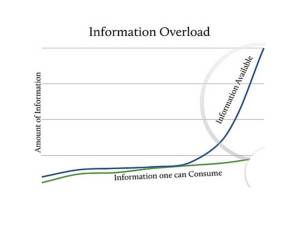Not too long ago we needed design tools like an artist’s palette demands a variety of colors; both to provide many ways to communicate both cognitively and emotionally. Now we have the technological capacity to deliver learning to anyone in the learning style to which they best respond across multiple platforms irrespective of time and geography. With the gate down learning designers can roam far and wide (and deep) to match content, to methods of communication to outcomes.
The challenge is just because we can do anything doesn’t mean we have to do everything. The temptation to employ every idea and methodology is an organic consequence of information overload. And pushed at us by the hour (minute, second?) in all kinds of forms has in many ways had the effect of distracting our ability to solve problems. Rather than making learning design more direct and focused, content is too easily diluted by non-essential information—that, while interesting and valuable—does nothing to amplify the quality of the learning solution. At the same time, as this graphic illustrates,  our brains just can’t take it all in. We’ve run out of cognitive space—and most of us do not delve any deeper, wider and in some cases outright ignore anything new having burnt out chasing the innovation comet.
our brains just can’t take it all in. We’ve run out of cognitive space—and most of us do not delve any deeper, wider and in some cases outright ignore anything new having burnt out chasing the innovation comet.
We Are In The Throes Of Pedagogical Pleonasm
What a wonderful word to describe the use of more words than necessary to express and idea. For instance, ‘at this moment in time” presumably means “now.” That’s an apt metaphor of the forces with which we contend. It’s fair to wonder how much is information in courseware is enough and how to maximize delivery for the strongest and most effective outcome.
Information overload, combined with powerful expressionistic tools suggest developers can all too easily be blown off course even when their instructional targets, objectives and KPIs are solid, and more importantly clear. Where the challenge used to be filling in minimal material driving instructional designers to request more help from SMEs, too much available content is driving us towards a condition of learning pleonasm.
The Cure – Specificity Is The Antidote For Distraction
What can a developer, learning designer or courseware developer do to ensure the required elements; the colors of the educational project are included while taming the information overload beast?
Here’s a list of those elements to think about when starting to build learning in a global environment crowded with information from which exclusions, rather than inclusions become more important. As white space on a page offers visual relief, often room for reflection in learning can come only from careful pruning.
- Prepare with Clarity
Long before objectives are even a mote on the screen, conversations with clients that result from questioning and probing; listening for cues and clues to what a client really expects as an end result will pay dividends later. Remember your client’s client is your learning target – not the payer. The performance that gets measured often means continually reminding the ‘paying’ client that understanding.How will those who complete the course differ in knowledge, skills, and decision making, from their naïve colleagues? I’ve yet to see a statement on an SOW that highlights those differences in writing. We write around it but we just assume…and that is too vague.
2. Write highly targeted, clearly demonstrable objectives
No matter how many projects I lead or, I am continually flummoxed by outcomes written by experienced instructional designers that offer no demonstrable measurement to check for acquisition of learning. Going one-step further not only developing the objective, but articulating the way in which each will be taught and assessed. And put it in writing.
3. Ensure you include KPIs
Key performance indicators drill down one-step deeper articulating specific qualities (or quantities) within each objective. Many times KPIs are most effective if ranked in a rubric or table with the most desirable condition at one end and the unacceptable at the other en
4. Operate with Precision
Instead of building in standard ISD form, with outlines, chapters, sections, modules and such, work the opposite way. Give in to information overload; put anything and everything related to the topic into a narrative overview. Then, with the objectives and KPIs on a giant billboard, bring out the scalpel and cut away anything that offers no direct benefit to the learning.
5. Ensure there are milestones and reviews, a standard practice that now takes on added importance – emblazon the objectives across the top of every QA review document,
6. Perform cohort studies for each group of learners when the course completes.
Since each has had the same experience, discover if your courseware or project has had the intended effect or outcomes. When comparing two courses as equal as possible, the one that has applied these steps should be more effective in learning uptake, time on course, and even likeability.
So…in our information rich world, the best courseware and education you will build resists the temptation to include every fact and figure that imparts more information, but in doing so dilutes specific performance objectives. More is often just…more, not better. What serves the learner and leads to desired performance outcomes signals your vanquishing information overload.

Dear Rich, this was a very interesting post. I’d be keen to connect with you and have a chat about information overload (www.linkedin.com/in/tobyruckert) – we’re building a solution to solve this (see http://unifiedinbox.com) and I’d love your input!
Pingback: TAMING INFORMATION OVERLOAD BEFORE IT DEVOURS | Instructional Design repertoire | Scoop.it